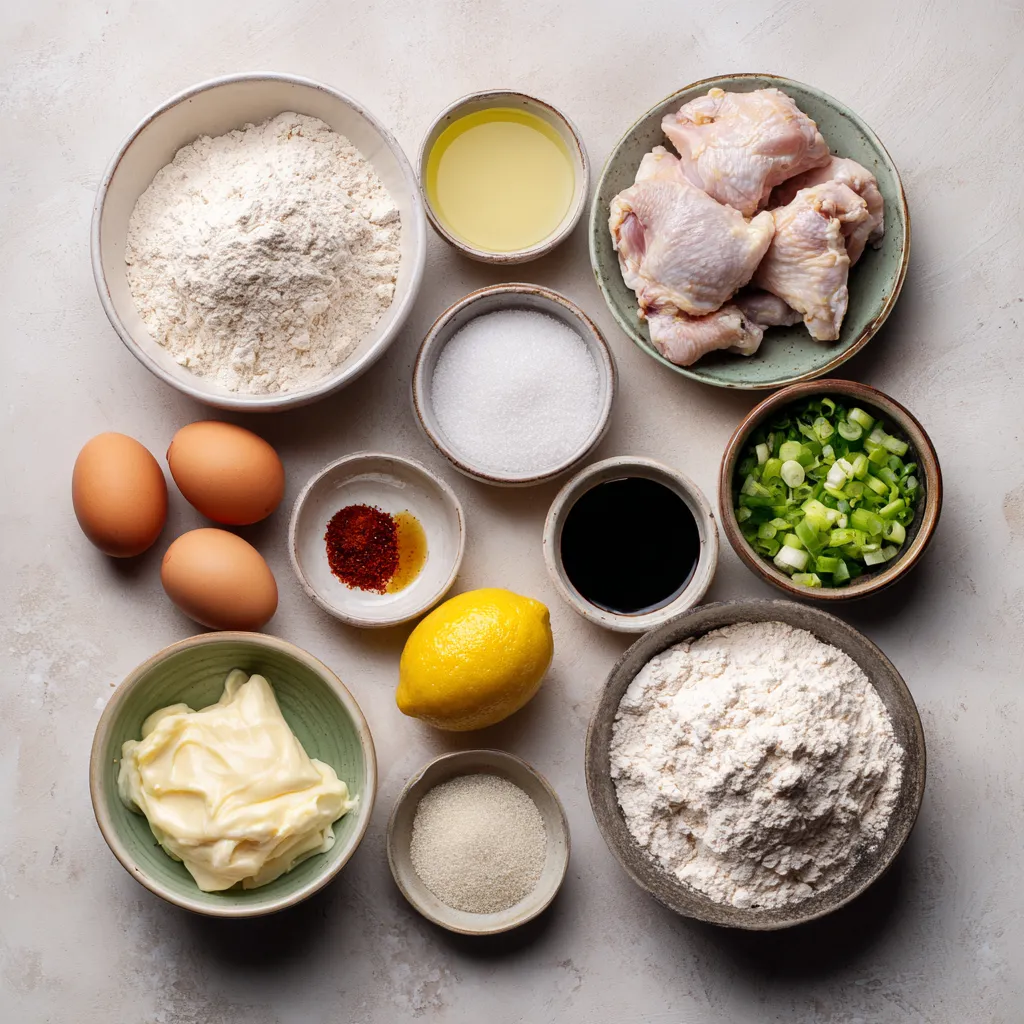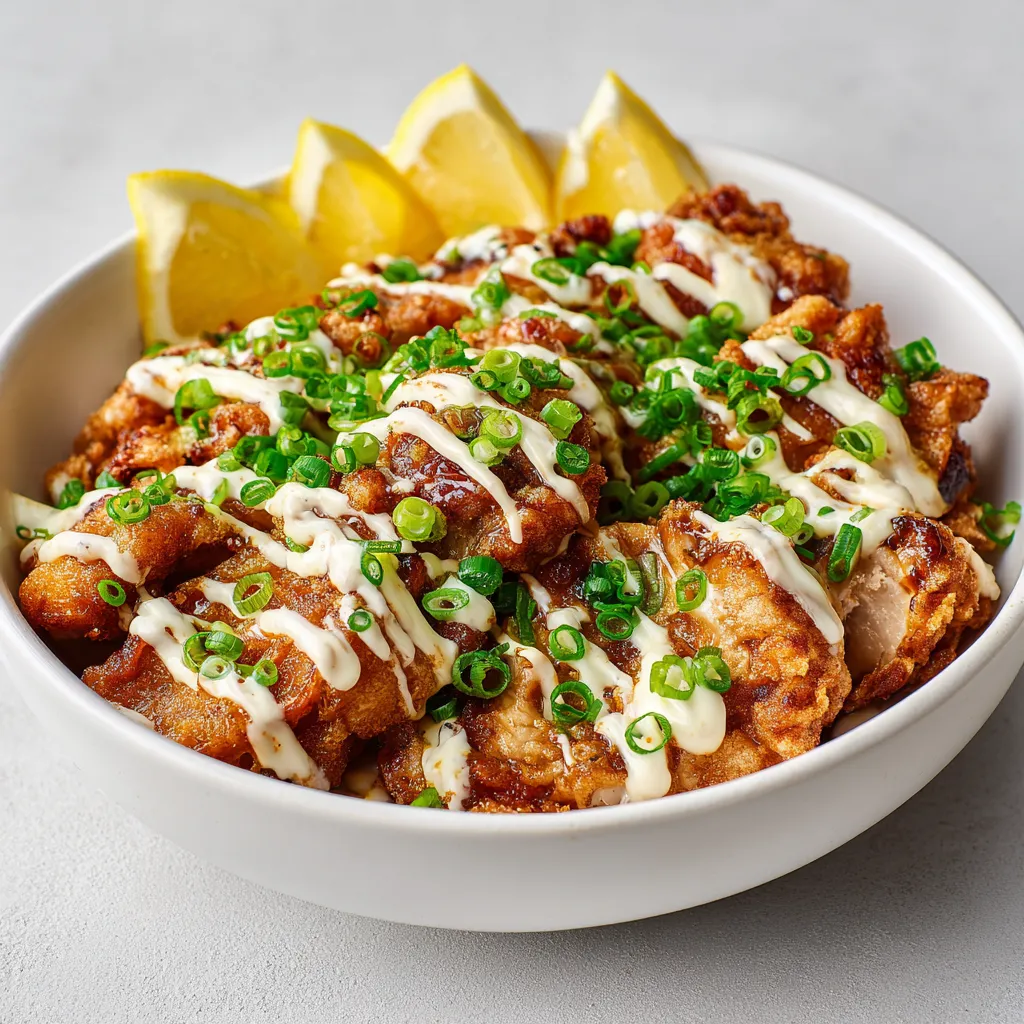Introduction
Exploring the world of savory flavors, Chicken Nanban Delight is a Japanese-inspired dish that pairs perfectly with a variety of sides. The dish transforms tender chicken thighs into a succulent entrée that captures the essence of Japanese comfort food. Marinated in buttermilk, the chicken absorbs rich flavors and remains incredibly juicy. The tangy Nanban sauce, combined with a creamy mayonnaise drizzle, elevates this dish, making it not just a meal but a beautifully plated experience.
Traditionally enjoyed in various dining settings, Chicken Nanban is a delightful option for both weeknight dinners and special occasions. Its versatility shines, as it can be served alongside steaming bowls of rice or fresh salads, enhancing the flavors and bringing a well-rounded meal to your table.
Recipe Overview
– Total Time: 1 hour
– Servings: 4
– Difficulty: Not specified in the recipe.
This dish features a delightful variety of flavors and textures, blending the tenderness of chicken with the crunch of its coating and the refreshing zing of the sauce. Chicken Nanban reflects elements of Japanese cooking that emphasize freshness and balance. As you delve into creating this dish, you will appreciate its flavor profiles and the techniques involved, which highlight the beauty of Japanese cuisine.
Origin of Nanban Cuisine
Nanban cuisine has its roots in the 16th century, stemming from the interaction between Portuguese traders and Japan. The term “Nanban” was used to refer to the Southern Barbarians, representing the foreign influences that introduced new ingredients and cooking techniques. The adaptation of such ingredients into Japanese culinary practices highlights the rich tapestry of flavors that define Nanban dishes. Today, Chicken Nanban showcases a unique blend of savory, tangy, and slightly sweet notes, embodying the cultural fusion that characterizes its origins.
Flavor Profile
The flavor profile of Chicken Nanban Delight is an exquisite combination of savory, tangy, and sweet elements. The buttermilk marinade infuses the chicken with moisture and flavor, while the smoked paprika adds a unique depth with its subtle smokiness. The Nanban sauce, made from soy sauce and rice vinegar, introduces a delightful umami that balances nicely with the sweetness derived from mirin and sugar. The freshness of green onions and the creamy richness of mayonnaise round out the dish, making each bite a harmonious experience. Completing it with a squeeze of lemon offers a refreshing brightness to counterbalance the savory notes, resulting in a satisfying and well-rounded meal.
Ideal Pairings
Chicken Nanban Delight pairs beautifully with a variety of side dishes. Traditional choices include steamed rice, which complements the flavors and allows the sauce to be soaked up. A vibrant garden salad adds a refreshing crunch and enhances the overall meal experience. You might also consider serving it with pickled vegetables for a contrasting tang that aligns perfectly with the savory chicken. For beverages, a light Riesling or chilled sake can enhance the dining experience, accentuating the dish’s unique taste without overpowering it.
Ingredients
– 4 boneless, skinless chicken thighs
– 1 cup buttermilk
– 1 cup all-purpose flour
– 1/2 cup cornstarch
– 1 teaspoon salt
– 1/2 teaspoon freshly ground black pepper
– 1 teaspoon smoked paprika
– Vegetable oil (for frying)
– 1/2 cup soy sauce
– 1/4 cup rice vinegar
– 2 tablespoons mirin
– 2 tablespoons granulated sugar
– 2 green onions, finely chopped
– 2 large eggs, beaten
– 1/4 cup mayonnaise
– Lemon wedges (for serving)
Main Ingredients
The primary ingredients for Chicken Nanban Delight include boneless, skinless chicken thighs, which are quintessential to ensuring a juicy and flavorful dish. Thighs, as opposed to breasts, offer a richer taste and a higher fat content, which contributes to moistness, especially when marinated. The buttermilk plays a pivotal role in the marination process, tenderizing the chicken and adding a subtle tanginess that enhances the overall flavor.
Coating Mixture
To achieve the crispy, golden coating that Chicken Nanban is known for, a mixture of all-purpose flour and cornstarch is used. Combining these two ingredients not only helps achieve the desired crunch but also serves to lock in the moisture of the chicken. Seasonings in the coating, notably salt, pepper, and smoked paprika, contribute significantly to the flavor, ensuring the crispy crust has its own flavor profile that complements the chicken.
Sauce Ingredients
The sauce creates a vibrant element in the dish. Soy sauce and rice vinegar are staples that offer a savory umami depth, while mirin adds a sweetness that beautifully balances the tangy notes of the vinegar. The addition of granulated sugar in the sauce enhances this sweetness, serving to harmonize all the flavors present in the dish.
Garnishes and Extras
Finishing touches such as finely chopped green onions bring a fresh, crisp contrast to the rich chicken and sauce. The drizzle of mayonnaise adds a creamy component, which pairs well with the crunchy texture of the fried chicken. Lemon wedges are essential for serving, as a squeeze of lemon juice brightens the dish, providing a burst of acidity that cuts through the richness and enhances the overall flavor.

Marinating the Chicken
To prepare the Chicken Nanban Delight, it all starts with marinating the chicken. This step is vital to ensure the chicken absorbs all the flavor and reaches an optimal level of tenderness.
Preparing the Marinade
For the marinade, simply place the boneless chicken thighs in a mixing bowl and pour in the buttermilk. The buttermilk acts as an acid, breaking down the protein and helping to tenderize the meat. It’s crucial to ensure every piece of chicken is fully submerged in the buttermilk for flavor consistency.
Duration of Marination
The recommended duration for marinating chicken thighs is a minimum of one hour. However, for optimal flavor penetration and tenderness, marinating overnight is encouraged. This extended time allows the buttermilk to work its magic, ensuring every bite of chicken is succulent and imbued with flavor.
Chicken Preparation
Once marinated, it’s essential to remove the chicken from the buttermilk and allow any excess to drip off. This ensures that the coating adheres properly during the frying process, preventing clumps and promoting an even crust that is delightful and satisfying.
Creating the Coating
After the chicken has marinated, the next step is preparing the coating mixture, which is crucial for achieving that beloved, crispy fried texture.
Blending Ingredients
In a separate bowl, combine the all-purpose flour, cornstarch, salt, pepper, and smoked paprika. Mixing these ingredients well guarantees that each piece of chicken will be evenly coated, contributing to a uniform texture and flavor. The cornstarch plays a significant role in adding to the crunchiness of the final product, while the spices enhance the overall flavor.
Importance of Even Coating
To ensure the chicken is well-coated, it’s vital to follow a two-step process: first covering the marinated chicken in the flour mixture, then dipping it in the beaten eggs for an additional layer, and finally returning to the flour mixture. This method promotes a thicker, crisp coating that helps maintain moisture inside while providing a satisfying crunch outside.
Making the Nanban Sauce
The final touch to the dish is the Nanban sauce, which infuses Chicken Nanban with its unique flavor.
In a small saucepan over medium heat, whisk together the soy sauce, rice vinegar, mirin, and sugar. Continuous stirring is important until the sugar fully dissolves, allowing the flavors to meld beautifully. Once the mixture comes to a gentle simmer, reduce the heat to low and allow it to cook for an additional 2–3 minutes. This slight cooking time helps deepen the flavors while ensuring the sauce remains vibrant and fresh. After removing it from the heat, letting the sauce cool will enhance its final taste, providing the perfect balance when drenching the fried chicken.
{{image_4}}
Combining Sauce Ingredients
To create the vibrant Nanban sauce, begin by carefully measuring out the ingredients. Use a liquid measuring cup for the soy sauce and rice vinegar, ensuring you’re exact for balanced flavor. The soy sauce adds umami depth, while the rice vinegar contributes tanginess. Next, measure 2 tablespoons of mirin with a tablespoon measure, then add the 2 tablespoons of granulated sugar. This combination is crucial for achieving a harmonious sweet and savory profile. In a small saucepan, whisk these ingredients together thoroughly, allowing them to blend seamlessly before applying heat.
Cooking the Sauce
Turning the stovetop to medium heat, place the saucepan with the combined ingredients on the burner. Constant stirring is essential during this process to prevent any burning at the bottom of the pan. As the mixture heats, observe for gentle bubbles indicating a simmer. Allow the sauce to simmer for 2 to 3 minutes, continuing to stir until the sugar has fully dissolved and the mixture is slightly thickened. Recognizing when the sauce is ready comes with visual cues; it should have a glossy appearance and a rich aroma.
Frying the Chicken
Preparation of Frying Pan
When it comes to frying the chicken, selecting the right vessel is key. Use a heavy-bottomed frying pan or skillet, which distributes heat evenly. Pour in enough vegetable oil to cover the bottom of the pan to a depth of about 1/2 inch. To test if the oil is adequately heated, sprinkle a pinch of the coating mixture into the oil; it should sizzle immediately. Alternatively, you can also use a kitchen thermometer to ensure the oil reaches around 350°F (175°C), which is perfect for frying.
Coating Process
Once the oil is hot, retrieve the marinated chicken from the refrigerator. Working one piece at a time, remove it from the buttermilk and allow any excess to drip off. Next, coat the chicken in the flour, cornstarch, and spice mixture. Be sure to cover the chicken evenly, pressing lightly to ensure the coating adheres well. After the first coating, dip the chicken into the beaten eggs, allowing it to be encased in this rich layer before rolling it a second time in the flour mixture. This double-coating technique will enhance the crunchiness of your final fried chicken.
Frying Techniques
Carefully lower the coated chicken pieces into the hot oil, ensuring not to overcrowd the pan to maintain even cooking and crispness. Allow each piece to fry undisturbed for approximately 5-6 minutes per side or until they appear golden brown and crispy. If cooking in batches, it’s advisable to return the oil to the correct temperature between batches. Checking the internal temperature with a meat thermometer ensures that the chicken reaches a safe 165°F (75°C), vital for both safety and achieving the best texture.
Draining and Soaking
Proper Drainage
After successfully frying the chicken, use a slotted spoon or tongs to remove each piece and transfer them to a plate lined with paper towels. The paper towels are essential for absorbing excess oil, helping to keep the chicken’s exterior crisp while preventing it from becoming greasy. Ensure not to stack the chicken pieces to allow for maximum drainage.
Soaking in Sauce
For the ideal finish, immediately dunk the fried chicken into the freshly prepared Nanban sauce, allowing it to soak for about 3 minutes. This soaking is crucial as it allows the chicken to absorb the sauce’s flavor, adding moisture and a beautifully tangy glaze to each bite. The result is tender, juicy chicken with a deeply flavored exterior.
Preparing to Serve
Arranging on Platter
To present Chicken Nanban beautifully, use a large platter or a rustic wooden board. Before placing the chicken, consider adding a layer of fresh greens or slaw underneath for color contrast. Gently arrange the pieces of chicken on the platter, showcasing their golden crust and succulent texture to entice your guests.
Additional Saucing
Before serving, a light drizzle of additional Nanban sauce over the top can elevate the dish further, enhancing both flavor and visual appeal. This extra touch makes for a delightful presentation while ensuring every bite is packed with flavor.
Making the Creamy Mayo Drizzle
Mixing Mayonnaise
In a small bowl, start with your mayonnaise and add a few teaspoons of water, one at a time, mixing after each addition. Your goal is to achieve a pourable consistency that can enhance the dish without overpowering it. This technique helps create a creamy drizzle that complements the crispy chicken with its smooth texture.
Purpose of the Drizzle
The mayo drizzle serves a dual purpose: it adds creaminess to contrast the crispiness of the chicken and provides a cooling element to the dish. The richness of the mayonnaise balances the tang of the Nanban sauce, creating a well-rounded flavor experience that delights the palate.
Garnishing and Presentation
Adding Fresh Green Onions
To finalize your presentation, sprinkle finely chopped green onions over the chicken for a pop of color and a fresh burst of flavor. Their slight crunch contrasts beautifully with the tender chicken, adding an appetizing touch to the overall dish.
Lemon Wedges Presentation
Position lemon wedges strategically around the platter. This not only enhances the visual appeal but also grants easy access for guests to squeeze fresh lemon juice over their servings when desired. The acidity from the lemon adds an extra layer of brightness that complements the savory chicken and tangy sauce.
Conclusion
Chicken Nanban Delight is an exquisite dish that combines multi-dimensional flavors with a satisfying crispy texture, ideal for various occasions. The marinating and frying processes create succulent chicken pieces that soak up the tangy Nanban sauce, resulting in a dish that is both rich and refreshing. With a manageable total preparation time, this recipe is perfect for quick weeknight dinners or for impressing at special gatherings.


